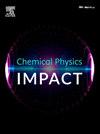Identification of pharmacophore synergism for optimization of estrogen receptor beta binders for hormone dependent forms of breast cancer
IF 4.3
Q2 CHEMISTRY, PHYSICAL
引用次数: 0
Abstract
Certain forms of breast cancer, particularly influenced by estrogen hormone, prompt the investigation of estrogen receptors as potential targets for therapeutic interventions. The drug discovery pipeline against breast cancer requires the identification and retention of crucial pharmacophoric features of inhibitors using a multitude of inhibitors comprising diverse scaffolds. In the present study, our focus was on conducting an e-QSAR (easy, efficient, economical, ecofriendly, and explainable QSAR), molecular docking and molecular dynamics simulations analyses on a diverse range of inhibitors that target Estrogen Receptor beta. The newly developed QSAR model upholds a balance between predictive accuracy with R2tr = 0.799, Q2LMO = 0.792, and CCCex = 0.886 and also provides mechanistic insights, thus adhering to the guidelines set forth by the Organisation for Economic Co-operation and Development (OECD). The analyses reveal that atoms with sp2-hybridization, specifically carbon and nitrogen atoms, have a significant impact on the binding profile along with lipophilic atoms. Additionally, a specific combination of hydrogen bond donors and acceptors involving carbon, nitrogen, and ring sulfur atoms also plays a crucial role. These novel findings have the potential to greatly aid future drug development targeting estrogen receptor beta.

激素依赖性乳腺癌雌激素受体结合物优化药效团协同作用的鉴定
某些类型的乳腺癌,尤其是受雌激素影响的乳腺癌,促使雌激素受体作为治疗干预的潜在靶点的研究。针对乳腺癌的药物发现管道需要使用包含不同支架的多种抑制剂来识别和保留抑制剂的关键药效特征。在本研究中,我们的重点是进行e-QSAR(简单,高效,经济,生态友好,可解释的QSAR),分子对接和分子动力学模拟分析多种雌激素受体抑制剂。新开发的QSAR模型维持了R2tr = 0.799, Q2LMO = 0.792和CCCex = 0.886的预测精度之间的平衡,并且还提供了机制见解,从而坚持了经济合作与发展组织(OECD)制定的指导方针。分析表明,具有sp2杂化的原子,特别是碳原子和氮原子,对亲脂原子的结合谱有显著影响。此外,氢键供体和受体的特定组合,包括碳、氮和环硫原子,也起着至关重要的作用。这些新发现有可能极大地帮助未来针对雌激素受体β的药物开发。
本文章由计算机程序翻译,如有差异,请以英文原文为准。
求助全文
约1分钟内获得全文
求助全文
来源期刊

Chemical Physics Impact
Materials Science-Materials Science (miscellaneous)
CiteScore
2.60
自引率
0.00%
发文量
65
审稿时长
46 days
 求助内容:
求助内容: 应助结果提醒方式:
应助结果提醒方式:


